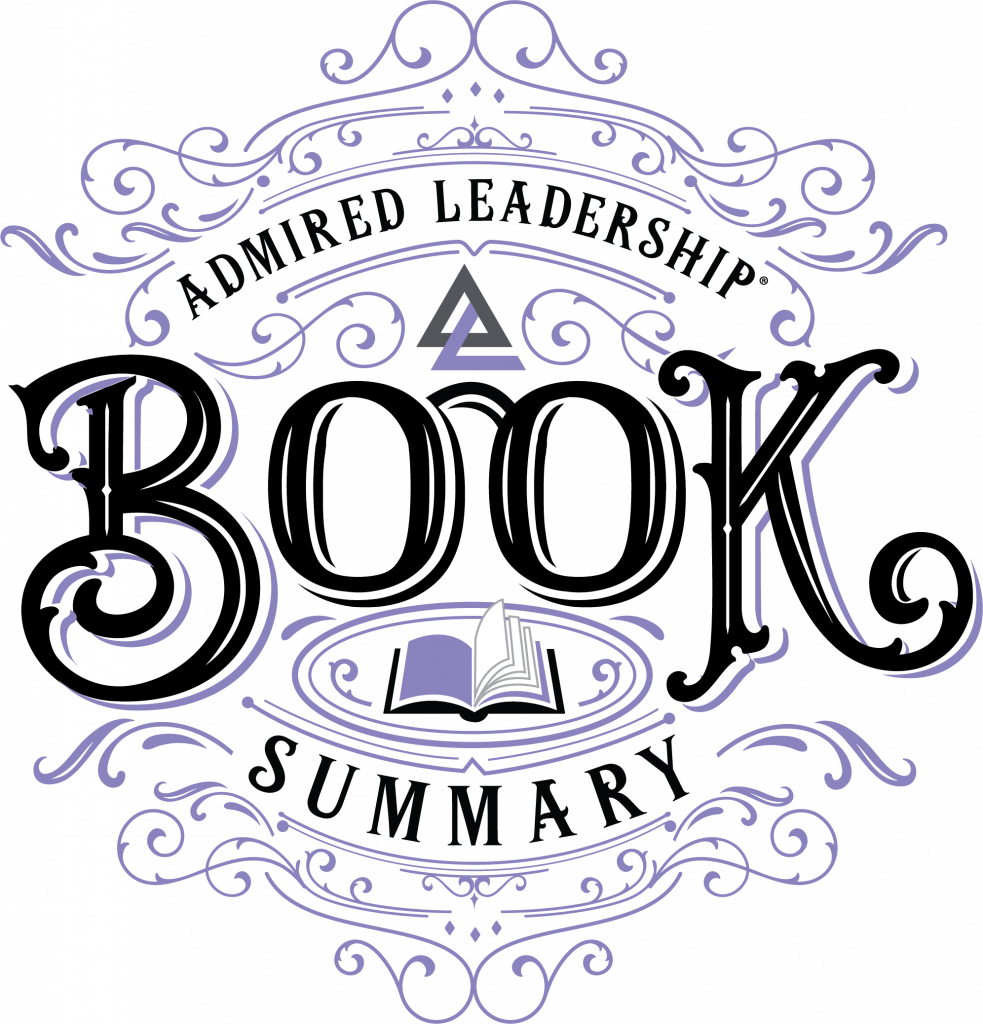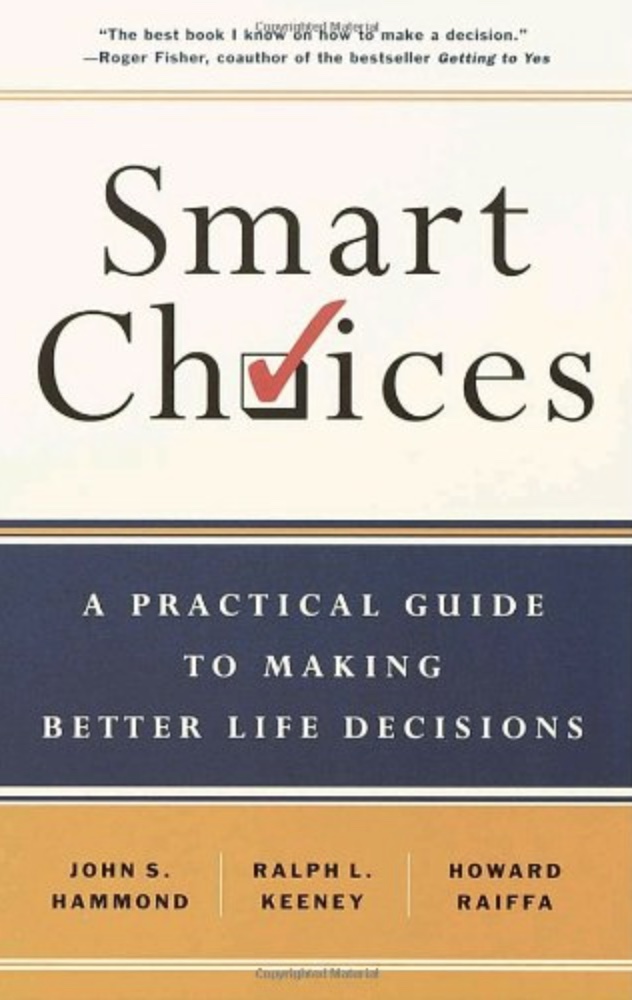Key Quote:
“The essence of making smart decisions is planning ahead” (p. 167).
Key Points and Concepts
General Guidelines for Decision Making
Even the most complicated problems can be solved using the PrOACT method of decision making. The letters of the PrOACT acronym — Problem, Objectives, Alternatives, Consequences, Tradeoffs — represent the core elements that must be considered when making any decision. Three additional elements — uncertainty, risk tolerance, and linked decisions — help clarify decisions in inconsistent or evolving environments (p. 5).
A solid decision-making process does not guarantee a positive outcome, and a poor decision-making process does not guarantee a negative outcome. However, a good decision-making process increases our chances for success and helps us restore control to our lives during stressful situations (p. 13).
Defining the Problem
“A good solution to a well-posed decision problem is almost always a smarter choice than an excellent solution to a poorly posed one” (p. 16). Be creative about how you define your problem. The easiest or most obvious way is not always the best way. A fresh perspective when framing a long-standing problem will often lead to new and useful insights (pp. 16-17).
Proactivity is key when making choices. Turn decision problems into opportunities by creating your own decision situations before an external trigger, or initiating force, arises. For example, evaluate your career path on a regular basis rather than waiting until you receive an inadequate raise (pp. 18-19).
Define the decision problem by asking yourself:
• What triggered the decision? Why am I considering it?
•What are the constraints and scope of my problem statement?
• What are the essential elements of my problem?
• What other decisions depend on this decision problem?
• How would others contextualize my problem (pp. 19-23)?
Clarifying Objectives
Formulating your objectives prompts you to consider your wants, needs, hopes, and goals. Objectives form the basis of evaluating the alternatives available to you (p. 31).
Objectives help you determine what information to gather before making a decision. They can also help you explain your decision to others and measure a decision’s importance (p. 33).
Practice identifying objectives by:
• Writing down the concerns you want to address as concise phrases consisting of a verb and an object.
• Separating fundamental objectives (the essential things we want to achieve) from means objectives (the things that help us achieve fundamental objectives).
• Testing your objectives by using them to evaluate potential alternatives and reflecting on your level of comfort with the resulting decisions (pp. 36-41).
Creating Alternatives
Alternatives can be understood as the choices or options available when making a decision (p. 47).
“You can never choose an alternative you haven’t considered,” and “no matter how many alternatives you have, your chosen alternative can be no better than the best of the lot” (p. 47). It is in your best interest to generate as many potential alternatives as possible, rather than choosing between a narrow range of unsatisfactory options.
Use these techniques to generate alternatives:
• Ask “how” you plan to fulfill your objectives.
• Challenge real (physical) and assumed (psychological) constraints.
• Do your own thinking before consulting others to maximize originality.
• Learn from your past experiences and the perspectives of others. Give your subconscious time to operate (pp. 50-54).
Understanding Consequences
“Be sure you really understand the consequences of your alternatives before you make a choice. If you don’t, you surely will afterwards, and you may not be very happy with them” (pp. 65-66). Examining potential positive and negative consequences prior to making a decision helps you understand the future impact of your decision.
To ensure full understanding of the possible outcomes of a decision, make sure your consequence descriptions are accurate, complete, and precise (pp. 66-67).
After eliminating clearly inferior alternatives based on your consequence descriptions, create a consequences table to visually compare all aspects of the remaining alternatives. This can be accomplished by creating a matrix with objectives listed across one side and alternatives listed across the other. The matrix format allows for comparing how each alternative meets or falls short of an objective in a concise and orderly format. When filling in the boxes of the matrix, use common scales to describe the consequences (dollars or percentages). This will prevent confusion or miscommunication with others. However, do not rely only on quantitative data at the expense of including important desires that are less tangible. (pp. 67-76).
Compromising through Tradeoffs
“Decisions with multiple objectives cannot be resolved by focusing on any one objective” (p. 83). For this reason, compromises between objectives must be made in order to reach a decision.
When making tradeoffs, you can first eliminate alternatives by looking at dominance. “If alternative A is better than alternative B on some objectives and no worse than B on all other objectives, B can be eliminated from consideration. In such cases, B is said to be dominated by A — it has disadvantages without any advantages” (p. 85). Alternatives can also be eliminated through the use of practical dominance, or when small disadvantage of option A clearly outweighs the cost of the larger disadvantages associated with option B.
When no alternatives are clearly dominated, the even swaps method can be used to even out advantages and disadvantages systematically until you are left with a clear choice. “An even swap increases the value of an alternative in terms of one objective while decreasing its value by an equivalent amount in terms of another objective. In essence, the even swaps method is a form of bartering — it forces you to think about the value of one objective in terms of another” (pp. 90-91). When using the even swaps method, it is more important to focus on the amounts in question rather than the relative importance of the objective.
Uncertainty
A risk profile can help you judge the likelihood of different alternatives and assess their possible impact on a decision (p. 112). A risk profile answers four essential questions:
• What are the key uncertainties?
• What are the possible outcomes of these uncertainties?
• What are the chances of occurrence of each possible outcome?
• What are the consequences of each outcome (p. 112)?
When a risk profile does not provide enough information to make a complex decision, a decision tree can be used. A decision tree provides a graphical representation of all pathways and interrelated outcomes that result from each alternative. “Just as a builder would not set out to construct a house without a blueprint, a decision maker will often require a decision tree to resolve a tough choice under uncertain conditions” (pp. 123-24).
Risk Tolerance
A person’s attitude towards risk can be stated as his or her risk tolerance. Individuals tend to be risk averse, meaning that they weigh poor consequences more heavily than favorable ones. The more risk averse someone is, the more they will weigh the downside when making decisions. Individuals are most likely to take risks when the positive consequences are both highly likely and highly desirable (p. 138).
Take your risk tolerance into account when making decisions. You can do so by assigning desirability scores to each of your potential consequences with 100 as the most desirable and 0 as the least.
If assigning desirability scores is difficult or if there are too many consequences to easily compare, a desirability curve can be used to assign scores. A desirability curve allows you to plot a few representative consequences and connect them to form a curve that will represent any possible consequence with a single, numerical value. An upward-bowed curve represents a risk averse attitude. Meanwhile, a downward-bowed curve represents a risk-seeking attitude (pp. 138-154).
“An organization’s leaders should take three simple steps to guide subordinates in dealing successfully with risk. First, sketch desirability curves that reflect the risk-taking attitude of the organization. Second, communicate the appropriate risk tolerance by issuing guidelines that include examples of how typical risky decisions should be handled. Third, examine the organization’s incentives to ensure they are consistent with the desired risk-taking behavior” (p. 157).
Linked Decisions
The decisions you make now will impact the decisions you make in the future. These are called linked decisions (p. 163).
“The essence of making smart decisions is planning ahead” (p. 167). To make the best decision today, you need to consider how your decision will impact the alternatives available to you in the future.
Linked decisions can be analyzed by following six steps:
• Understand the decision problem.
• Identify ways to reduce uncertainties.
•Identify future decisions linked to current decisions.
• Understand relationships in linked decisions through the use of decision trees.
• Decide what to do in the current decision.
• Treat later decisions as new decision problems (pp. 168-172).
Hammond, J. S., Keeney, R. L., & Raiffa, H. (2015). Smart Choices: A Practical Guide to Making Better Decisions. Brighton: Harvard Business Review Press.

“Even the most complicated problems can be solved using the PrOACT method of decision making. The letters of the PrOACT acronym — Problem, Objectives, Alternatives, Consequences, Tradeoffs — represent the core elements that must be considered when making any decision.”
“Be sure you really understand the consequences of your alternatives before you make a choice. If you don’t, you surely will afterwards, and you may not be very happy with them.”
“When a risk profile does not provide enough information to make a complex decision, a decision tree can be used. A decision tree provides a graphical representation of all pathways and interrelated outcomes that result from each alternative. “Just as a builder would not set out to construct a house without a blueprint, a decision maker will often require a decision tree to resolve a tough choice under uncertain conditions” .”
“The essence of making smart decisions is planning ahead.” To make the best decision today, you need to consider how your decision will impact the alternatives available to you in the
future.”
